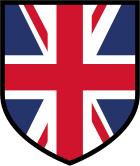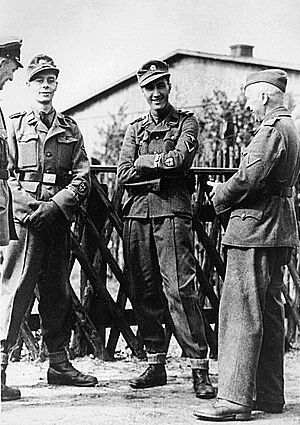British Free Corps facts for kids
Quick facts for kids British Free Corps |
|
|---|---|

Armshield
|
|
| Active | 1943–1945 |
| Allegiance | |
| Branch | |
| Type | Infantry |
| Role | Waffen-SS auxiliary |
| Size | 54 (total membership) 27 (maximum strength) |
| Disbanded | 1945 |
The British Free Corps (also known as the BFC) was a small military group formed by Nazi Germany during World War II. It was made up of British and other Commonwealth soldiers who had been captured by Germany. These soldiers were prisoners of war (POWs).
The group was first called the Legion of St George. A historian named Adrian Weale found that 54 different men were part of this unit at some point. However, it was always very small. At its biggest, it had only 27 members.
Contents
How the British Free Corps Started
The idea for the British Free Corps came from John Amery. He was a British man who supported fascism, a type of political belief. His father, Leo Amery, was a government official in Britain.
John Amery's Role in Forming the BFC
John Amery went to Berlin in October 1942. He suggested to the Germans that they create a British volunteer group. This group would help Germany fight against the Bolsheviks (a term used for communists in the Soviet Union).
Amery wanted the British group to be like the French volunteer group. This French group was already fighting with the German army. John Amery also made radio broadcasts to try and get British people to join. He encouraged them to fight against communism.
Where the BFC Members Came From
The first people to join the BFC were prisoners of war. They were held at a special 'holiday camp' in Genshagen, near Berlin. This camp was set up by the Germans in August 1943.
In November 1943, these prisoners moved to a café in Pankow, a part of Berlin. More recruits also came from a camp in Luckenwalde in late 1943. The BFC officially became a military unit on January 1, 1944.
Training and Locations of the BFC
In February 1944, the BFC moved to a place called St Michaeli Kloster in Hildesheim. This was a small town near Hanover. The members received their uniforms on April 20, 1944.
Later, on October 11, 1944, the Corps moved to Dresden. There, they started military training for fighting on the Eastern Front. They moved again in February and March 1945, staying in Berlin and then Niemegk.
How the Germans Tried to Recruit POWs
The Germans tried to get more prisoners of war to join the Free Corps. In 1944, they gave out leaflets in POW camps. The unit was also mentioned in Camp, a newspaper for prisoners published in Berlin.
The Germans presented the BFC as a group of volunteers. They said these volunteers were British subjects from all over the British Empire. They claimed these men wanted to fight against Soviet Russia. The Germans believed their enemies were as worried about the Soviets as they were.
Who Led the British Free Corps?
The BFC never had a British "commander" as the SS hoped to find a suitable British officer. Instead, three German Waffen-SS officers acted as "liaison officers." They were in charge of the unit for discipline and daily operations.
- SS-Hauptsturmführer Hans Werner Roepke: September 1943 – November 1944
- SS-Obersturmführer Dr Walter Kühlich: November 1944 – April 1945
- SS-Hauptsturmführer Dr Alexander Dolezalek: April 1945
Some people thought a British officer named Brigadier Leonard Parrington was involved. He had visited the POW 'holiday camp' in Genshagen in 1943. However, he was just checking on the prisoners. He did not approve of the BFC.
Members of the British Free Corps
Some of the main members of the Corps included:
- Thomas Haller Cooper
- Roy Courlander
- Edwin Barnard Martin
- Frank McLardy
- Alfred Minchin
- John Wilson
These men were sometimes called the 'Big Six'. Their importance in the group changed over time. In 2002, it was said that Robert Chipchase, an Australian, was the last living member. He stated he changed his mind about joining and spent the rest of the war in a punishment camp.
The BFC's Role in the War
In March 1945, a small group from the BFC joined the 11th SS Volunteer Panzergrenadier Division Nordland. This division was mainly made up of volunteers from Scandinavian countries. They were sent to different locations, including Stettin and Angermünde.
The BFC group was part of the division's armored reconnaissance battalion. They were led by SS-Scharführer Douglas Mardon, who used the name "Hodge." They were stationed near the Oder River.
The End of the BFC's Service
On April 16, 1945, the Corps moved to Templin. They were supposed to join the transport company of General Felix Steiner's headquarters. As the Nordland Division moved towards Berlin, the BFC went with Steiner's headquarters to Neustrelitz.
Towards the end of the war, on April 29, Steiner decided to move his forces west. He wanted them to surrender to the American and British forces. The last two members of the Corps, Thomas Haller Cooper and Fred Croft, surrendered on May 2. They gave up to the 121st Infantry Regiment (United States) in Schwerin.
What Happened After the War
After the war, several soldiers from Commonwealth countries who were part of the Corps faced consequences. For example, a Canadian prisoner named Private Edwin Barnard Martin said he joined the Corps to try and cause problems from the inside. He even designed the flag for the Corps. He was found responsible for helping the enemy while he was a prisoner of war.
A soldier from New Zealand, Roy Courlander, also claimed he joined for similar reasons. He said he wanted to gather information on the Germans or cause trouble for the unit.
John Amery, who first suggested the British Free Corps, faced serious consequences for his actions against his country in November 1945.
Images for kids
See also
- Non-Germans in the German armed forces during World War II
- Indian Legion
- List of members of the British Free Corps
- Waffen-SS foreign volunteers and conscripts
- Free Corps Denmark






